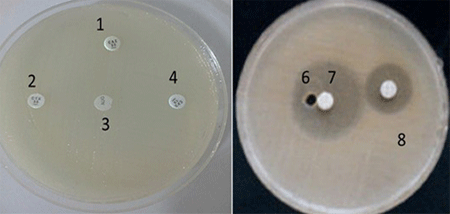Detection of invA and blaCTM-genes in Salmonella spp. isolated from febrile patients in Lagos hospitals, Nigeria
Authors: Kabiru O. Akinyemi, Christopher O. Fakorede, Rebecca O. Abegunrin, Samuel O. Ajoseh, Abdul-Azeez A, Anjorin, Kehinde O Amisu, Bolanle O. Opere and Dauphin D. Moro
Ger. J. Microbiol.
2021.
vol. 1, Iss. 3
pp:1-10
Doi: https://doi.org/10.51585/gjm.2021.3.0008

Abstract:
Salmonella infections remain a global challenge. The culture method is the gold standard for the detection of genus Salmonella. The application of Polymerase Chain Reaction (PCR) has become an effective tool for the detection of virulence and antimicrobial resistance genes. This study investigated the prevalence of Salmonella by culture and detection of invA gene and blaCTX-M and blaCTX-M-3 gene markers by PCR. A total of 612 blood samples were collected from hospitalized febrile patients between March 2020 and April 2021. The samples were cultured, isolates identified by standard method with Analytical Profile Index (API 20-E) kits, and were subjected to in-vitro antimicrobial susceptibility test (AST) using disk diffusion method. Extended-spectrum beta-lactamase (ESBL) detection was carried out by double-disc synergy test. Detection of invA gene and antibiotic-resistant genes makers was done by qPCR. A total of 24 Salmonella isolates were identified given a prevalence of 3.9% Salmonella-associated bacteremia. Children within 1-10 years with persistent pyrexia of unknown origin (PUO) accounted for 50% of the Salmonella isolated with a mean age of 5.299 years. Specifically, 75% (18/24) Salmonella isolates and their corresponding samples of positive Salmonella culture were positive for the invA gene. The AST results indicated 100% Salmonella isolates developed resistance to ceftazidime, cefotaxime, augmentin, ampicillin, ertapenem, and doripenem. None of drug resistant-Salmonella isolates expressed ESBL enzyme phenotypically. Seven resistance patterns were observed, and the pattern CAZ-CTX-OFL-AUG-NIT-AMP-ETR-DOR was the most encountered pattern. Twelve (50%) Salmonella isolates harbored the blaCTX-M and blaCTX-M-3 genes and were mostly from children. The study has added to the growing knowledge on the suitability of the invA gene primer set as a PCR target for the detection of Salmonella. It also revealed a paradigm shift in the occurrence of invasive Salmonella harboring blaCTX-M and blaCTX-M-3 genes in PUO cases. There is a need for judicious use of cephalosporin and carbapenem antibiotics to preserve their efficacies.
Keywords:
Salmonella, qPCR, invA, resistance, blaCTX-M, fever, Lagos
Statistics:
Article Views: 2617
PDF Download: 53